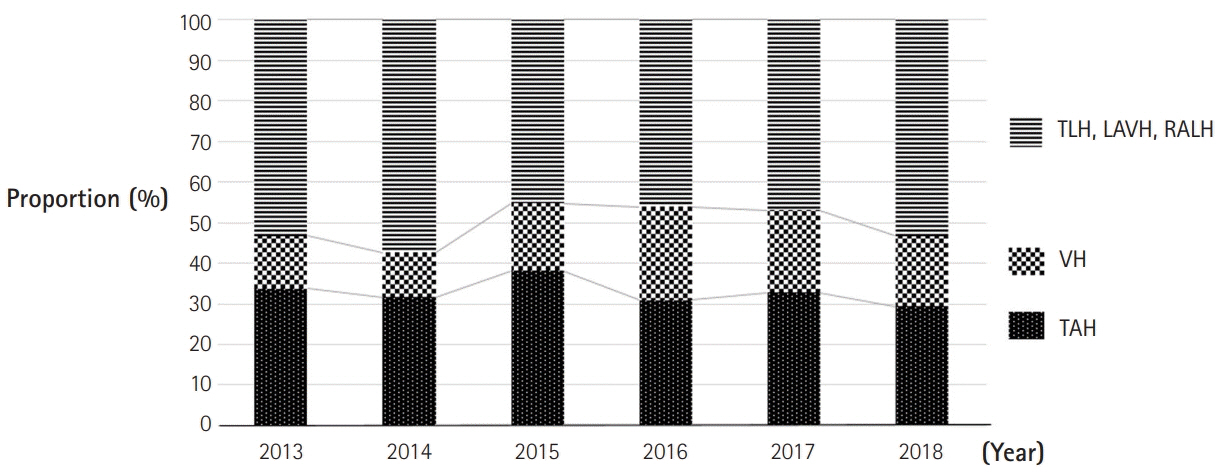Yeungnam Univ J Med.
2020 Oct;37(4):308-313. 10.12701/yujm.2020.00185.
Clinical outcomes of hysterectomy for benign diseases in the female genital tract: 6 years’ experience in a single institute
- Affiliations
-
- 1Department of Obstetrics and Gynecology, Yeungnam University Hospital, Daegu, Korea
- 2Department of Obstetrics and Gynecology, Yeungnam University College of Medicine, Daegu, Korea
- KMID: 2508176
- DOI: http://doi.org/10.12701/yujm.2020.00185
Abstract
- Background
Hysterectomy is one of the major gynecologic surgeries. Historically, several surgical procedures have been used for hysterectomy. The present study aims to evaluate the surgical trends and clinical outcomes of hysterectomy performed for benign diseases at the Yeungnam University Hospital.
Methods
We retrospectively reviewed patients who underwent a hysterectomy for benign diseases from 2013 to 2018. Data included the patients’ demographic characteristics, surgical indications, hysterectomy procedures, postoperative pathologies, and perioperative outcomes.
Results
A total of 809 patients were included. The three major indications for hysterectomy were uterine leiomyoma, pelvic organ prolapse, and adenomyosis. The most common procedure was total laparoscopic hysterectomy (TLH, 45.2%), followed by open hysterectomy (32.6%). During the study period, the rate of open hysterectomy was nearly constant (29.4%–38.1%). The mean operative time was the shortest in the single-port laparoscopic assisted vaginal hysterectomy (LAVH, 89.5 minutes), followed by vaginal hysterectomy (VH, 96.8 minutes) and TLH (105 minutes). The mean decrease in postoperative hemoglobin level was minimum in single-port LAVH (1.8 g/dL) and VH (1.8 g/dL). Conversion to open surgery or multi-port surgery occurred in five cases (0.6%). Surgical complications including wound dehiscence, organ injuries, and conditions requiring reoperation were observed in 52 cases (6.4%).
Conclusion
Minimally invasive approach was used for most hysterectomies for benign diseases, but the rate of open hysterectomy has mostly remained constant. Single-port LAVH and VH showed the most tolerable outcomes in terms of operative time and postoperative drop in hemoglobin level in selected cases.
Keyword
Figure
Reference
-
References
1. Korea National Health Insurance Service (NHIS). The main surgery statistical yearbook for 2017 [Internet]. Wonju: NHIS;2018. [cited 2020 Mar 10]. https://www.nhis.or.kr/menu/boardRetriveMenuSet.xx?menuId=F3326.2. Nevis IF, Vali B, Higgins C, Dhalla I, Urbach D, Bernardini MQ. Robot-assisted hysterectomy for endometrial and cervical cancers: a systematic review. J Robot Surg. 2017; 11:1–16.
Article3. Committee on Gynecologic Practice. Committee opinion no. 701: choosing the route of hysterectomy for benign disease. Obstet Gynecol. 2017; 129:e155–9.4. Aarts JW, Nieboer TE, Johnson N, Tavender E, Garry R, Mol BW, et al. Surgical approach to hysterectomy for benign gynaecological disease. Cochrane Database Syst Rev. 2015; (8):CD003677.
Article5. Elessawy M, Schollmeyer T, Mettler L, Jonat W, Schem C, von Hehn U, et al. The incidence of complications by hysterectomy for benign disease in correlation to an assumed preoperative score. Arch Gynecol Obstet. 2015; 292:127–33.
Article6. Song T, Kim MK, Kim ML, Jung YW, Yun BS, Seong SJ. A randomized comparison of laparoendoscopic single-site hysterectomies: total laparoscopic hysterectomy versus laparoscopically assisted vaginal hysterectomy. J Laparoendosc Adv Surg Tech A. 2015; 25:541–7.
Article
- Full Text Links
- Actions
-
Cited
- CITED
-
- Close
- Share
- Similar articles
-
- Risk of incidental genital tract malignancies at the time of myomectomy and hysterectomy for benign conditions
- Comparsion of clinical course according to the various method of total hysterectomy in benign gynecologic disease
- Single-port access laparoscopic staging operation for a borderline ovarian tumor
- Recent advances in minimally invasive surgery for gynecologic indications
- Influence of minilaparotomy total hysterectomy on clinical course of patients


